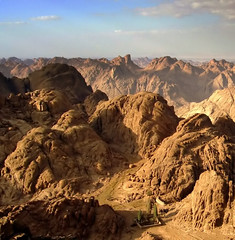“Evolution is a walk across a rugged landscape,” that’s what theoretical biologists (the guys who crunch the numbers) would say.
Well, what the hell have I been doing? Heck, you can still be in a relationship and feel the muscle burn from climbing up and down.
“Evolution is nature's way of solving problems.” That’s another thing theoretical biologists argue. Of course, they’re not aiming at domestic tranquility with this point. For Biology, the main problem for a bacterium (or anybody else) is how to survive long enough to reproduce. This is the arena of survival of the fittest and natural selection, where genetically distinct individuals compete for limited resources. Those that do best produce more offspring.
Again, you say there's no connection here to working out a long term relationship… But wait there is. Because, as perfectly fit individuals do well, and are fat and happy in their little ecological niche, things change.
AH yes, “We were doing so well and then things changed.” It happens to even the most fit organism. For no environment is stable. Sooner or later everything will change. And then what happens? How does evolution cope with a moving target?
The rule is, “Evolve or Die.” And if you haven’t read the headlines on the emergence of antibiotic resistance, let me tell you, bugs are great at doing this. They manage to evolve quickly, and find new genetic solutions.
Faced with a changing environment (and who isn't), bacteria explore a vast range of alternative genetic solutions. Theoretical biologists have created a model to map out this behavior. They call it an "adaptive landscape," or better yet a "rugged landscape." It's a metaphoric tool to describe this genetic prospecting; an abstract mathematical space with an undulating surface of hills and valleys.
The height of any point on this landscape corresponds to the genetic fitness of an organism to its environment. The highest peaks represent those genetic combinations which produce the highest fitness. Movement on the landscape corresponds to changes in the organism's genetic constitution- changes made as it evolves and seeks to survive and reproduce.
Fuelled by mutation and driven by natural selection, organisms will tend to march uphill toward fitness peaks and once there hunker down to enjoy the good life... until conditions change. Suddenly, they’re no longer fit. They are thrown into a deep valley and have to begin again that evolutionary walk. If they don’t, they die.
They die right there in the pits. Now, tell me, is this not a great metaphor for relationships? Is it not more than a romantic image? There is mathematics here. (In fact, given that a bacterium has about 4000 genes, a true adaptive landscape is a space of 4000 dimensions… Don’t try to go there, it will not help.)
The take home message here is simple. What’s true for a bacterium surviving in the gut, is not that different from two people trying to survive in a relationship. Or for that matter, economists have applied this knowledge to innovation in business. And, I think it also applies to our surviving on the planet.
If you what to survive long enough to blossom, if you want to live a life truly suited to your surroundings- you must evolve or die.
And despite the impression one may receive from the media, meditation is not simply a means to reduce stress. Meditation is about one thing ultimately- it is a means, perhaps the best we have, to evolve our consciousness.


No comments:
Post a Comment